With the help of correctly selected materials, their combination, overall dimensions and color scheme, it is possible to highlight the working area in the kitchen area. In this article, we will learn from what to make an apron in the kitchen, as well as get acquainted with the sequence of the workflow.

Features of arranging an apron from various materials
To find the best option for arranging a working area in the kitchen, you need to familiarize yourself with the strengths and weaknesses of each of the possible materials. Wallpaper for this purpose is rarely used, because such products will soon become dirty and may become unusable from constant cleaning of the surface. As an exception - vinyl roll materials with additional glass or transparent plastic protection.
Attention! Earned on our website kitchen designer. You can familiarize yourself with it and design your dream kitchen for free! May also come in handy wardrobes designer.
The most budgetary option is the use of a film with a decorative pattern. It can be glued to the wall surface or fixed to the base with staple brackets. The service life of such a product is limited; if necessary, it can be replaced with a new copy.
Ceramic tile
The most popular design option for an apron is the use of tiles. Ceramic tiles have several advantages over other materials:
- long operational period;
- high indicators of product durability;
- good water resistance;
- ease of maintenance of the tile surface;
- relative inertness to the effects of chemicals;
- wide range of products.
The design of the working area with tiles can be very diverse. The surface is often made in one color, although in practice other compositions are also used, for example, with an ornament or with imitation of brickwork. With the right choice of tile color, the user can visually expand the space in the kitchen.
For laying ceramic tiles on the work surface, glue or cement-sand mortar is used. In order to perfectly align the apron, it is necessary to pre-seal all cracks, distortions and height differences on the base. With a separate installation of the working area, the tiles can be attached to the chipboard sheet.
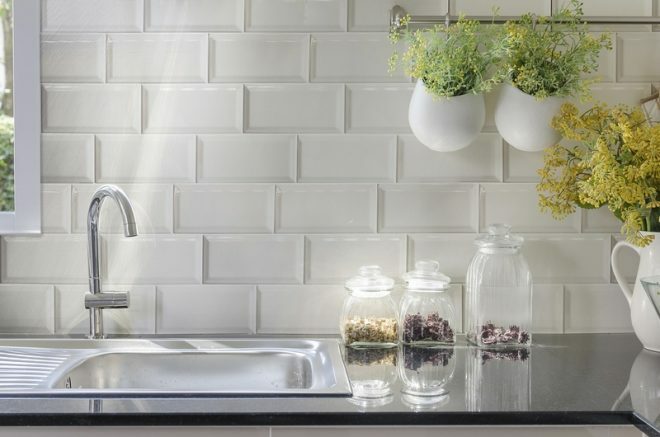
Mosaic
The apron of the kitchen working area is often made of mosaic elements. These include:
- glass of various colors;
- natural or artificial stone;
- metal products;
- ceramic elements;
- acrylic or plastic.
Mosaic products are a set of individual elements that are connected into a single whole using paper or a special mesh. The kitchen interior has a unique appearance, in which the worktop and apron are made of mosaics of the same color scheme.
The materials in question are expensive, so some users prefer to make a kitchen apron with their own hands from scrap materials. Pieces of broken dishes, remains of ceramic tiles and other similar products are used here as the main elements. The installation of such a working area is lengthy and requires work experience from the master.
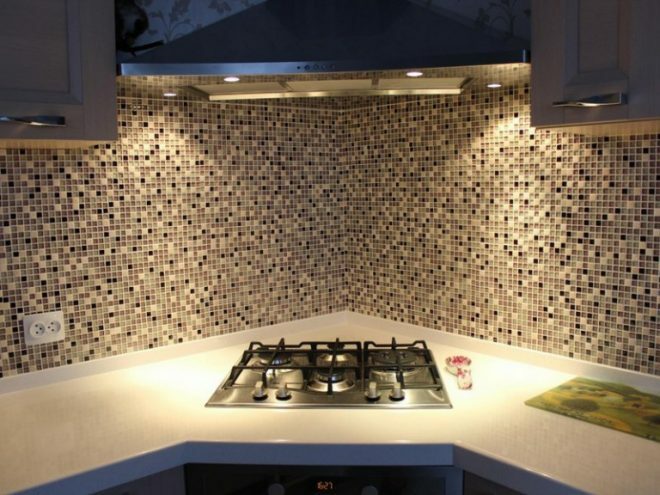
Artificial and natural stone
Many kitchen owners prefer to decorate the work area with expensive natural stone or an artificial analogue (porcelain stoneware, concrete and clinker tiles, large pebbles). These materials have a number of positive characteristics:
- resistance to sudden changes in temperature;
- low level of moisture absorption;
- ease of cleaning the surfaces of stone products, their hygiene;
- unlimited period of operation;
- environmental friendliness of the material.
The main disadvantages of the considered products are considered to be the complexity of laying, high cost and low level of maintainability.
Despite its presentable appearance, marble is not used in this business. The fact is that the surface of these materials can absorb moisture and unpleasant odors. Under the influence of an external aggressive environment, the structure of the stone will soon begin to deteriorate, and it will lose its decorative effect.
The second artificial material, porcelain stoneware, is similar in technical characteristics to ceramic tiles, but differs from its counterpart in increased strength and wear resistance. Such products are not often used for arranging a working area in a kitchen due to their increased weight and high cost. It is better to entrust the laying of porcelain stoneware to an experienced master.
To the question of how to decorate an apron in the kitchen, there is another answer - large pebbles. Such products without sharp corners hide all the irregularities of the base surface. The stones are laid on glue or cement-sand mortar. The technology for mounting large pebbles is quite simple, any man can handle this work.
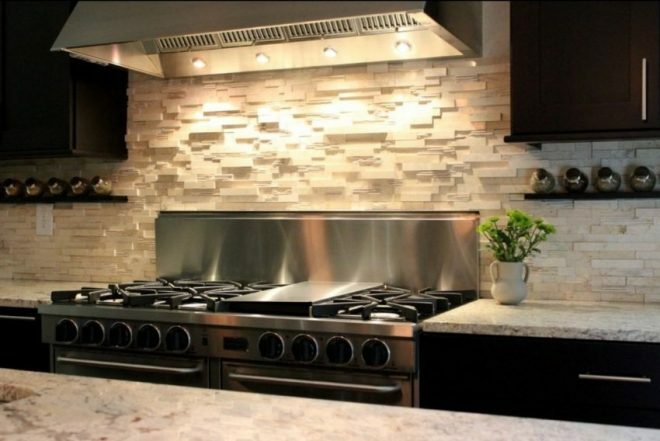
Wood or MDF
Many users choose laminated MDF panels, consisting of a backing and plastic or laminate, for decorating an apron. The best option for arranging the working area is considered to be the selection of the same color scheme as that of the working area. The panels are fixed on the surface with liquid nails.
The main advantage of the products in question is the ability to select the required piece of sheet, because the apron can go beyond the cladding. When working in the kitchen, splashes or dirty spots may appear on the decorative surface. They can be easily removed with a regular glass cleaner and sponge. Do not use abrasive substances for this purpose, as they can scratch the decorative surface.
The rapid wear of the MDF panel is associated with exposure to high temperatures. In areas near the slab, the coating often fades or deforms. Laminated panels have a low cost, if desired, they can be quickly replaced.
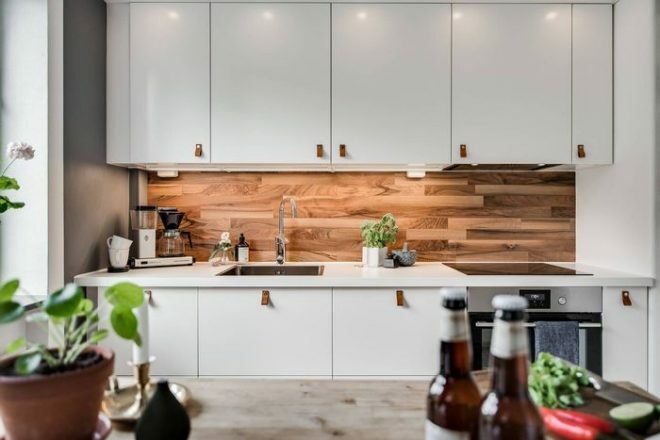
Glass
Glass is considered the most popular material for apron decoration due to the following advantages:
- high strength indicators;
- long service life;
- ease of care;
- decorative surface qualities;
- wear resistance;
- water resistance of the material;
- chemical inertness;
- high level of fire safety.
In the working area of the kitchen, triplex glass, reinforced with a film or a tempered analogue, is used. For decoration, use monochrome or transparent models, products with a background pattern effect.
A non-standard design solution will be to stick a mirror on a chipboard plate. Such a detail can visually expand the interior space in the kitchen. It should be noted that the mirror will quickly get dirty, so this element needs daily care.
Not every user knows how to make a do-it-yourself kitchen apron from glass. It is fixed on glue or special fittings, while the thickness of the element must be greater than 5 millimeters. Unhardened products are suitable for drilling, which allows them to be fixed on special rivets.
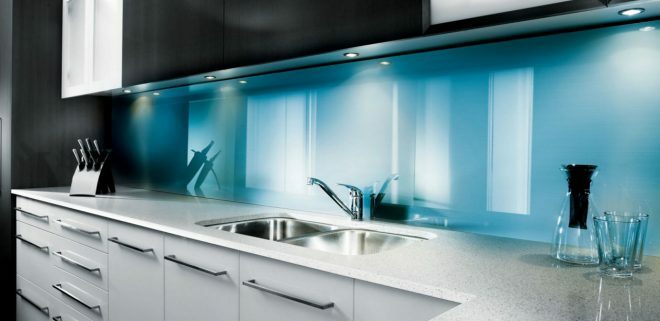
Metal
Metal products, specifically stainless steel, are used to create aprons when the kitchen is decorated in high-tech style. Such products are fixed on a glass surface using liquid nails. Such panels have a long shelf life; of the minuses, it is necessary to single out a small number of design solutions for models.
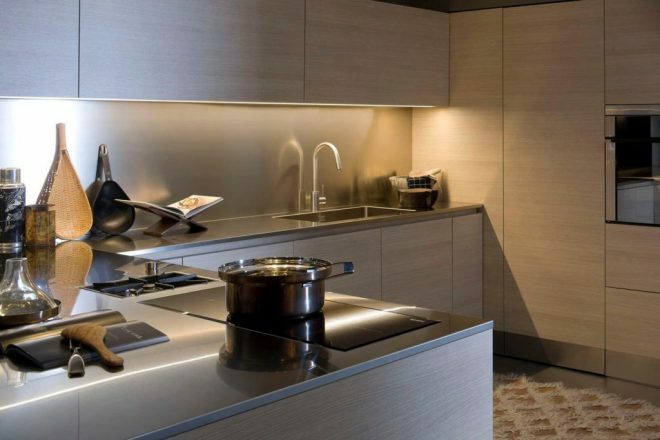
Brick apron
The working area with imitation of brickwork is made in various colors. The surface of such products can be smooth or textured. The material looks like a tile, it is laid with the bandaging of the seams like a regular brick. The main disadvantage of such an apron is considered the possibility of accumulation of fat and dirt in the working area, so the working area must be periodically cleaned of dirt. The material is suitable for any interior, it has good water-repellent properties and high strength.
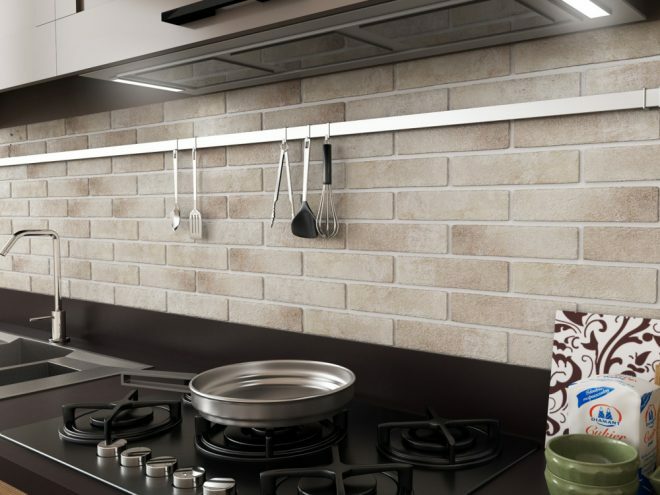
How to make an apron in the kitchen with your own hands
The process of installing the working area begins with the selection of the required material and surface preparation. Next, we will learn how to arrange an apron in the kitchen in detail.
Choosing an apron option
Materials must be selected in such a way that the working area is as functional as possible. Decorative items should be well cleaned from dirt and dust. In addition, when buying a material, you must pay attention to its resistance to sudden temperature changes, as well as moisture resistance.
The protective coating is fixed in the immediate vicinity of the stove or sink. Walls in these areas often suffer from waterlogging or splashes of grease, which contribute to the formation of persistent, non-removable stains. Cutting of vegetables or meat can take place in the working area of the kitchen. During work, food particles can also get on the walls, which is why some users place the apron throughout the entire countertop. In addition to functionality, the work area connects the kitchen furniture into a single whole, it should ideally fit into the existing interior.
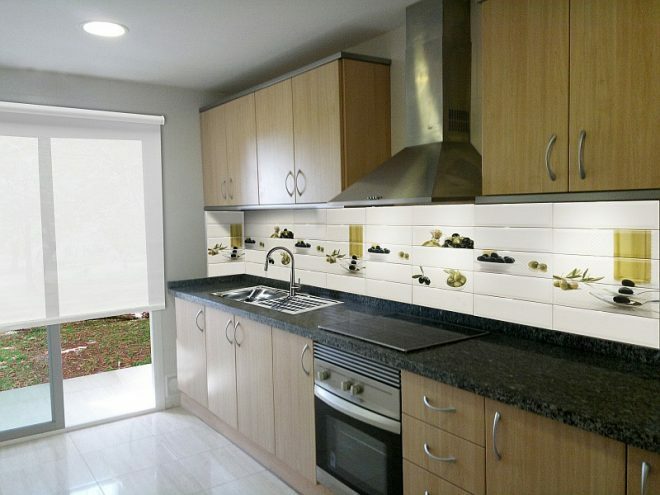
Determine the dimensions
When determining dimensions, you need to know in how many planes the working area is located. If the apron is located on two or three walls, then the user must find out the dimensions of each of the planes. The height of this structure will be determined by the difference between the elevations of the countertop and the kitchen facades overhanging from above.
The length depends on the size of the headset, the location of the gas stove and the sink in the room. If plumbing and household appliances are located in the corners of the wall, then the user must also add 50-70 centimeters to the work surface. With a side fit, the apron is made straight.
For example, the length of a standard kitchen set is 3 meters, while the sink and stove are in the middle of the room. In this case, the height of the canopy from the floor level will correspond to 1.4 meters, the length -3.5 meters. It is also necessary to make additional protection above the stove under the hood, possible dimensions are 75 * 90 centimeters.

Apron installation
Let's get acquainted with the process of installing the working area using the example of ceramic tiles. Such work is carried out according to the pre-applied markings before installing the kitchen furniture. First, you need to level the base, remove elevation differences and repair cracks.
At the next stage of work, it is necessary to determine the nature of the location of the tile on the surface. The tiles are laid in a straight or diagonal position, picking up the pattern and mounting the border, if this element is provided. Next, we make markings on the wall, determine the position of the upper and lower borders. At the bottom we fix a metal profile that will fix the bottom row of tiles.
We start the installation of the tile from the center and gradually move to the edges. So that the gaps between the individual elements are the same, we install plastic crosses. After fixing the tile to the surface, these elements are removed. Grouting is carried out two days after the end of the main work.
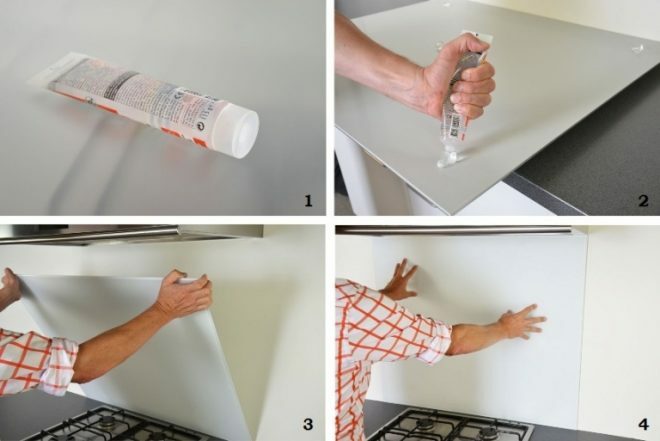
Conclusion
Whatever material is chosen for the apron device, the wrong work technology can ruin the entire surface. In this regard, it is necessary to carefully measure both the working area and specific materials. The work is carried out with great care, the result will be a beautiful decorative surface in the kitchen.